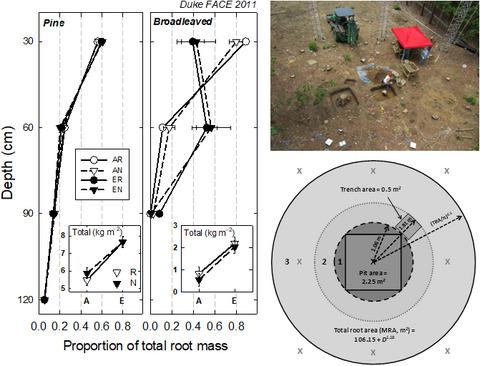当前位置:
X-MOL 学术
›
Glob. Change Biol.
›
论文详情
Our official English website, www.x-mol.net, welcomes your
feedback! (Note: you will need to create a separate account there.)
The response of coarse root biomass to long-term CO2 enrichment and nitrogen application in a maturing Pinus taeda stand with a large broadleaved component
Global Change Biology ( IF 10.8 ) Pub Date : 2021-11-16 , DOI: 10.1111/gcb.15999 Chris A Maier 1 , Kurt H Johnsen 2 , Pete H Anderson 1 , Sari Palmroth 3 , Dohyoung Kim 4 , Heather R McCarthy 5 , Ram Oren 6, 7
Global Change Biology ( IF 10.8 ) Pub Date : 2021-11-16 , DOI: 10.1111/gcb.15999 Chris A Maier 1 , Kurt H Johnsen 2 , Pete H Anderson 1 , Sari Palmroth 3 , Dohyoung Kim 4 , Heather R McCarthy 5 , Ram Oren 6, 7
Affiliation

|
Elevated atmospheric CO2 (eCO2) typically increases aboveground growth in both growth chamber and free-air carbon enrichment (FACE) studies. Here we report on the impacts of eCO2 and nitrogen amendment on coarse root biomass and net primary productivity (NPP) at the Duke FACE study, where half of the eight plots in a 30-year-old loblolly pine (Pinus taeda, L.) plantation, including competing naturally regenerated broadleaved species, were subjected to eCO2 (ambient, aCO2 plus 200 ppm) for 15–17 years, combined with annual nitrogen amendments (11.2 g N m−2) for 6 years. Allometric equations were developed following harvest to estimate coarse root (>2 mm diameter) biomass. Pine root biomass under eCO2 increased 32%, 1.80 kg m−2 above the 5.66 kg m−2 observed in aCO2, largely accumulating in the top 30 cm of soil. In contrast, eCO2 increased broadleaved root biomass more than twofold (aCO2: 0.81, eCO2: 2.07 kg m−2), primarily accumulating in the 30–60 cm soil depth. Combined, pine and broadleaved root biomass increased 3.08 kg m−2 over aCO2 of 6.46 kg m−2, a 48% increase. Elevated CO2 did not increase pine root:shoot ratio (average 0.24) but increased the ratio from 0.57 to 1.12 in broadleaved species. Averaged over the study (1997–2010), eCO2 increased pine, broadleaved and total coarse root NPP by 49%, 373% and 86% respectively. Nitrogen amendment had smaller effects on any component, singly or interacting with eCO2. A sustained increase in root NPP under eCO2 over the study period indicates that soil nutrients were sufficient to maintain root growth response to eCO2. These responses must be considered in computing coarse root carbon sequestration of the extensive southern pine and similar forests, and in modelling the responses of coarse root biomass of pine–broadleaved forests to CO2 concentration over a range of soil N availability.
中文翻译:

阔叶松成熟林中粗根生物量对长期 CO2 富集和施氮的响应
升高的大气 CO 2 (eCO 2 ) 通常会增加生长室和自由空气碳富集 (FACE) 研究中的地上生长。在这里,我们在 Duke FACE 研究中报告了 eCO 2和氮改良对粗根生物量和净初级生产力 (NPP) 的影响,其中 30 年生火炬松 ( Pinus taeda , L. ) 种植园,包括竞争的自然再生阔叶树种,经受 eCO 2(环境,aCO 2加 200 ppm)的影响 15-17 年,同时每年进行氮修正(11.2 g N m -2) 6 年。收获后开发了异速生长方程以估计粗根(> 2 mm直径)生物量。eCO 2下的松树根生物量增加了 32%,比在 aCO 2中观察到的 5.66 kg m -2增加了 1.80 kg m -2,主要在土壤表层 30 cm 中积累。相比之下,eCO 2使阔叶根生物量增加了两倍以上(aCO 2:0.81,eCO 2:2.07 kg m -2),主要在30-60 cm 的土壤深度中积累。与 6.46 kg m -2的 aCO 2相比,松树和阔叶根生物量增加了 3.08 kg m -2,增加了 48%。CO 2升高没有增加松树根茎比(平均 0.24),但在阔叶树种中将比例从 0.57 增加到 1.12。根据研究(1997-2010 年)的平均值,eCO 2 分别使松树、阔叶树和粗根 NPP 增加了 49%、373% 和 86%。氮修正对任何组分的影响较小,无论是单独的还是与eCO 2相互作用的。在研究期间,eCO 2下根系 NPP 的持续增加表明土壤养分足以维持根系生长对 eCO 2的响应。在计算广泛的南方松树和类似森林的粗根碳固存以及模拟松阔叶林粗根生物量对 CO 2的响应时,必须考虑这些响应土壤 N 有效性范围内的浓度。
更新日期:2022-01-16
中文翻译:

阔叶松成熟林中粗根生物量对长期 CO2 富集和施氮的响应
升高的大气 CO 2 (eCO 2 ) 通常会增加生长室和自由空气碳富集 (FACE) 研究中的地上生长。在这里,我们在 Duke FACE 研究中报告了 eCO 2和氮改良对粗根生物量和净初级生产力 (NPP) 的影响,其中 30 年生火炬松 ( Pinus taeda , L. ) 种植园,包括竞争的自然再生阔叶树种,经受 eCO 2(环境,aCO 2加 200 ppm)的影响 15-17 年,同时每年进行氮修正(11.2 g N m -2) 6 年。收获后开发了异速生长方程以估计粗根(> 2 mm直径)生物量。eCO 2下的松树根生物量增加了 32%,比在 aCO 2中观察到的 5.66 kg m -2增加了 1.80 kg m -2,主要在土壤表层 30 cm 中积累。相比之下,eCO 2使阔叶根生物量增加了两倍以上(aCO 2:0.81,eCO 2:2.07 kg m -2),主要在30-60 cm 的土壤深度中积累。与 6.46 kg m -2的 aCO 2相比,松树和阔叶根生物量增加了 3.08 kg m -2,增加了 48%。CO 2升高没有增加松树根茎比(平均 0.24),但在阔叶树种中将比例从 0.57 增加到 1.12。根据研究(1997-2010 年)的平均值,eCO 2 分别使松树、阔叶树和粗根 NPP 增加了 49%、373% 和 86%。氮修正对任何组分的影响较小,无论是单独的还是与eCO 2相互作用的。在研究期间,eCO 2下根系 NPP 的持续增加表明土壤养分足以维持根系生长对 eCO 2的响应。在计算广泛的南方松树和类似森林的粗根碳固存以及模拟松阔叶林粗根生物量对 CO 2的响应时,必须考虑这些响应土壤 N 有效性范围内的浓度。











































 京公网安备 11010802027423号
京公网安备 11010802027423号